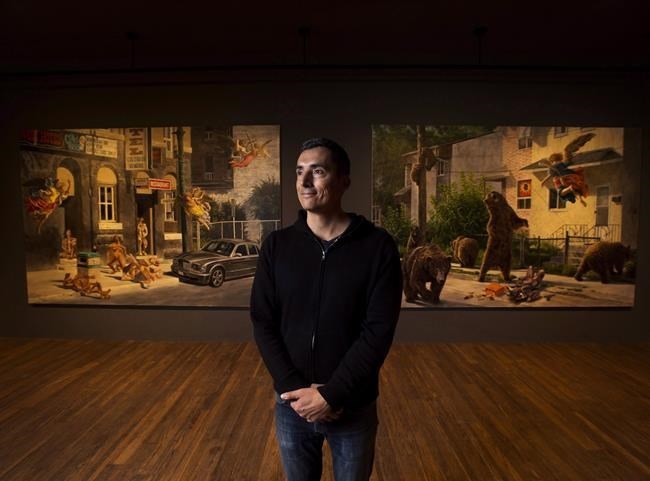Cree artist Kent Monkman is apologizing for a painting that critics say depicts Indigenous women laughing at a sexual assault of Prime Minister Justin Trudeau.
The Toronto-based artist's graphic portrayals of colonial violence in Canada have been featured in galleries across the globe, including a recent installation at the Metropolitan Museum of Art.
But critics say his latest work, "Hanky Panky," implicates Indigenous women, two-spirit and trans people in the violence Monkman purports to deconstruct, prompting the provocative painter to concede that he may have missed the mark.
"I deeply regret any harm that was caused by the work," Monkman wrote in an Instagram post Monday.
In a statement on his website Thursday, Monkman said he wasn't speaking with the media so he could focus on feedback from the community, and that the backlash will have a "lasting impact" on his work.
"Hanky Panky" shows a man resembling Trudeau crouched down on all fours with his pants pulled down to his knees, revealing his nude buttocks.
Monkman's gender-fluid alter-ego, Miss Chief Eagle Testickle, stands over him while holding up an object shaped like a red hand, while a group of men who resemble former prime ministers look on in consternation. A Mountie can be seen splayed out on the floor, his rear end also exposed.
The men are encircled by a group of laughing Indigenous women, a couple of whom seem to be holding down the Trudeau lookalike. One woman wraps her arm around the man's neck and snarls down at him, while another grips his buttocks and cackles.
In the caption, Monkman says the work highlights the problems of the "Canadian (in)justice system" that inflicts and ignores violence against Indigenous women and two-spirit people.
"In my own reimagining, through their laughter, a group of Indigenous women reclaim their agency," Monkman wrote.
But many viewers weren't laughing.
While some commenters applauded Monkman's willingness to push boundaries, many felt he crossed a line.
In his caption, Monkman writes that the work depicts a "consensual" encounter, but critics say this claim strains credulity.
Rowan Red Sky, an Oneida art historian based in Toronto, was among those who read the painting as a "revenge rape" fantasy.
Given that Indigenous women, trans and two-spirit people suffer sexual violence at disproportionate rates, Sky said the insinuation that they would delight in seeing similar trauma inflicted on someone else is a "kick in the gut."
In his Instagram post Monday, Monkman admits that "the elements I had included to indicate consent are not prominent enough."
He said he takes sole responsibility for the work's shortcomings, and expresses regret that others who participated in its creation were put in "harm's way."
Monkman often recruits models to pose for photos that form the basis for his paintings. As part of the rollout of "Hanky Panky," he shared a still from the shoot on social media.
Comparing the images, Sky said Monkman painted over some of the models' distinguishing features so the group would conform to gender and racial stereotypes about Indigenous women.
Moreover, Sky said the painting centres on masculine subjects, while the women are relegated to the periphery, casting them as bystanders in their supposed reclamation of agency.
In his apology, Monkman said that as a cisgender, two-spirit man, he's always sought to prioritize the safety of marginalized genders.
"I see that with this work, I have failed," he wrote.
Monkman also resolves to refrain from further references to the okihcitawiskwewak, whom he describes as a traditional council of Cree women lawkeepers, as a loose source of inspiration for the work.
Lindsay Nixon, a Cree-Metis-Saulteaux curator and editor at Canadian Art, said this allusion is hard to swallow given the respect Cree people hold for their "kookums," which means grandmothers, and aunties.
"For Kent Monkman to depict a rape ... in front of this very revered matriarchal facet of governance in my community, it was shocking for me," said Nixon.
Nixon noted that the shock value of Monkman's paintings have long been a source of criticism, with some suggesting his work is intended for a white spectatorship rather than Indigenous viewers.
What's surprising about Monkman's response to the outcry over "Hanky Panky" is that he apologized, said Nixon.
"That does give me hope that maybe there's a shift in discourse in these industries and that he has reflected on how this could be offensive."
However, as the controversy mounted in recent days, some supporters have suggested that Monkman has nothing to apologize for, including Ojibway Senator Murray Sinclair.
"Kent Monkman has produced another monumental testament to the treatment of Indigenous women and the public's lack of caring," Sinclair wrote on Facebook.
"I wish people were as shocked and angered at that visual as they are at Monkman's portrayal of it."
For Mississippi Choctaw activist and art historian Regan de Loggans, this line of argument ignores the ways in which Monkman benefits from and perpetuates "patriarchal privilege."
"It's a huge issue within our Indigenous communities," said de Loggans. "It's also a huge issue within the art world."
To show his solidarity with Indigenous women, trans and two-spirit people, Monkman needs to publicly shut down his defenders, said de Loggans.
"I challenge him to step up and say, 'No, I have made a mistake,'" de Loggans said. "I was educated by my kin and therefore will now educate my kin."
The prime minister's office did not return a request for comment.
This report by The Canadian Press was first published May 21, 2020.
Adina Bresge, The Canadian Press



